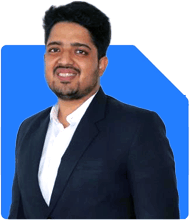Investing Guru: Is my investment plan suitable for retirement at 60?
Ramalingam Kalirajan | Answer |Ask -Follow
Mutual Funds, Financial Planning Expert - Answered on Oct 16, 2024
He has an MBA in finance from the University of Madras and is a certified financial planner.
He is the director and chief financial planner at Holistic Investment, a Chennai-based firm that offers financial planning and wealth management advice.... more

Sir, I am 44 years old. I have started investing in Mutual funds. I have invested @Rs 2000 each in 4 nos of mutual funds. SBI bluechip - SBI Small cap - Parag Parikh Flexi cap - Icici multi cap growth - How good a mix is this and how much my approximate wealth creation will be at 60. I also have an NPS of Rs 2500 p.m. NPS Vatsalya of Rs 2000 p.m. Provident fund investment of Rs 7000 p.m. Sukanya Samriddhi of Rs 1000 p.m. Other than LICs of around 15000 p.m. How is this strategy and do I need to change anything. I have a son and daughter and i am the sole earner in my family. Net salary is around Rs 94000 p.m. Kindly guide Regards G S Bhattacharya
Mutual Fund Mix Evaluation
You have chosen a mix of large-cap, small-cap, flexi-cap, and multi-cap funds. Let’s break this down:
SBI Bluechip (Large Cap): This fund focuses on stable, large companies. It offers consistent growth with lower risk compared to small- and mid-cap funds.
SBI Small Cap: Small-cap funds are known for high growth potential but come with higher volatility. It's good for long-term wealth creation if you can handle the risk.
Parag Parikh Flexi Cap: Flexi-cap funds provide a balanced approach as they invest across market caps. This fund adds diversification and flexibility to your portfolio.
ICICI Multicap Growth: Multi-cap funds offer broad exposure across large, mid, and small-cap stocks. This adds diversity and helps balance risk and return.
Your current mix is balanced with exposure to different market segments. However, you are investing only Rs 8,000 per month across four funds. If possible, consider increasing your SIPs over time to enhance your wealth creation.
You may also want to review your portfolio every year with a Certified Financial Planner to ensure it's aligned with your goals and risk tolerance.
NPS (National Pension System)
You are contributing Rs 2,500 per month to NPS, which is a good retirement tool. NPS offers a mix of equity, corporate bonds, and government securities. It also gives you the benefit of tax savings under Section 80C and 80CCD(1B). However, at Rs 2,500 per month, your contribution is relatively low. Increasing this amount will give you a more substantial retirement corpus.
NPS Vatsalya
Your Rs 2,000 contribution to NPS Vatsalya adds to your retirement planning. While both NPS and NPS Vatsalya are pension schemes, you need to assess whether maintaining both is necessary. A professional planner can help you decide if consolidating these investments might be more effective.
Provident Fund (PF)
Contributing Rs 7,000 per month to your Provident Fund is excellent for building a retirement corpus. It offers guaranteed returns and is a safe long-term investment. The tax benefits and safety make this an essential part of your strategy. You can continue this contribution as it builds a solid foundation for your retirement.
Sukanya Samriddhi Scheme (SSS)
You are contributing Rs 1,000 per month towards Sukanya Samriddhi for your daughter. This is a great step towards securing her future. It offers attractive interest rates, and the maturity is tax-free. This is one of the best tools for saving for your daughter’s education and marriage.
LIC Premiums
You are paying Rs 15,000 per month towards LIC policies. LIC offers security, but it’s crucial to assess whether these policies are insurance-cum-investment products. These policies often provide lower returns than mutual funds. It might be worth reconsidering your allocation to LIC, focusing on term insurance for protection and mutual funds for growth. If you find that these are traditional or ULIP policies, consider surrendering them and reinvesting in high-return mutual funds.
Wealth Creation by Age 60: Approximate Insights
Given your current investment pattern, let's look at potential wealth creation:
Mutual Funds: With a SIP of Rs 8,000 per month, assuming an average annual return of 12% over the next 16 years, your mutual funds can grow significantly. You could expect a corpus upwards of Rs 50-60 lakh, depending on market performance and how regularly you increase your SIP amounts.
NPS: Your Rs 2,500 contribution per month might result in a decent retirement corpus, depending on how long you continue investing and the equity-debt ratio of your NPS portfolio. Over time, you can expect this corpus to grow steadily.
Provident Fund: Your Rs 7,000 per month in PF contributions will continue building a safe and stable retirement corpus.
Sukanya Samriddhi: Your contributions towards Sukanya Samriddhi will grow until your daughter turns 21, and the tax-free maturity amount will help with her education or marriage.
However, exact wealth creation depends on how consistently you invest and whether you increase contributions over time. Periodic reviews with a Certified Financial Planner can give you better insights.
Family Protection and Financial Security
You mentioned that you are the sole earner in your family. It's crucial to protect your family with a pure term insurance plan rather than relying on LIC's traditional policies for both insurance and investment. Pure term insurance offers higher coverage at a lower cost.
Since you have a son and a daughter, ensuring they are financially secure is essential. You may need to assess your insurance coverage to ensure it meets your family's needs in case of unforeseen circumstances.
Suggestions for Improvement
While your strategy is solid, here are a few improvements to consider:
Increase SIPs Gradually: If your budget allows, gradually increase your SIPs. Even small increases can have a significant impact on your long-term wealth.
Focus on Term Insurance: If your LIC policies are investment-cum-insurance plans, consider switching to term insurance for higher life coverage at a lower cost. Reinvest the difference in mutual funds for better returns.
Review NPS Contributions: Consider increasing your NPS contributions if retirement security is a primary goal. The NPS can be a powerful tool for building a retirement corpus, but your current contributions may be on the lower side.
Keep an Emergency Fund: Ensure you have a sufficient emergency fund. Ideally, you should aim for 6-12 months of expenses saved in a liquid, safe investment like a savings account or liquid mutual fund.
Child’s Education Planning: Sukanya Samriddhi is excellent for your daughter. For your son, you may want to allocate additional savings towards his higher education through a dedicated investment plan.
Final Insights
Your current investment approach is diversified and provides a good balance between growth and safety. You have laid a strong foundation for retirement, children’s education, and insurance.
To further enhance your financial security:
Gradually increase your SIPs and NPS contributions.
Shift to term insurance for higher life cover.
Periodically review your portfolio to ensure it aligns with your long-term goals.
Lastly, don't hesitate to seek advice from a Certified Financial Planner for personalized guidance on growing and protecting your wealth.
Best Regards,
K. Ramalingam, MBA, CFP,
Chief Financial Planner,
www.holisticinvestment.in
https://www.youtube.com/@HolisticInvestment
You may like to see similar questions and answers below
Nikunj Saraf | Answer |Ask -Follow
Mutual Funds Expert - Answered on Mar 18, 2023
Ramalingam Kalirajan | Answer |Ask -Follow
Mutual Funds, Financial Planning Expert - Answered on May 26, 2024
Ramalingam Kalirajan | Answer |Ask -Follow
Mutual Funds, Financial Planning Expert - Answered on May 07, 2024
Ramalingam Kalirajan | Answer |Ask -Follow
Mutual Funds, Financial Planning Expert - Answered on Sep 25, 2024
Ramalingam Kalirajan | Answer |Ask -Follow
Mutual Funds, Financial Planning Expert - Answered on Feb 04, 2025
Dr Dipankar Dutta |1841 Answers |Ask -Follow
Tech Careers and Skill Development Expert - Answered on Dec 14, 2025
Nayagam P P | Answer |Ask -Follow
Career Counsellor - Answered on Dec 14, 2025
Radheshyam Zanwar |6744 Answers |Ask -Follow
MHT-CET, IIT-JEE, NEET-UG Expert - Answered on Dec 14, 2025
Radheshyam Zanwar |6744 Answers |Ask -Follow
MHT-CET, IIT-JEE, NEET-UG Expert - Answered on Dec 14, 2025
Dr Dipankar Dutta |1841 Answers |Ask -Follow
Tech Careers and Skill Development Expert - Answered on Dec 14, 2025
Dr Dipankar Dutta |1841 Answers |Ask -Follow
Tech Careers and Skill Development Expert - Answered on Dec 13, 2025
Dr Dipankar Dutta |1841 Answers |Ask -Follow
Tech Careers and Skill Development Expert - Answered on Dec 13, 2025
Mayank Chandel |2575 Answers |Ask -Follow
IIT-JEE, NEET-UG, SAT, CLAT, CA, CS Exam Expert - Answered on Dec 13, 2025
Radheshyam Zanwar |6744 Answers |Ask -Follow
MHT-CET, IIT-JEE, NEET-UG Expert - Answered on Dec 13, 2025
Mayank Chandel |2575 Answers |Ask -Follow
IIT-JEE, NEET-UG, SAT, CLAT, CA, CS Exam Expert - Answered on Dec 13, 2025
























